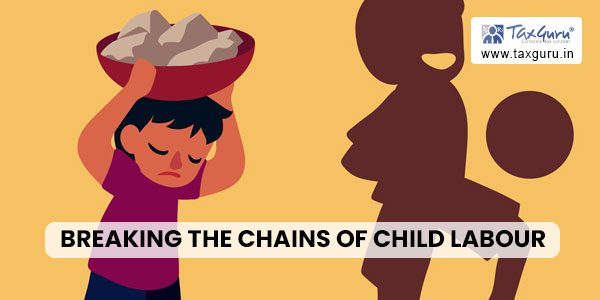INTRODUCTION:
Child labour is defined as the act of employing children in any type of work that causes children to lose out on their childhood, potential, dignity, and hinders their physical and mental growth. According to the International Labour Organization (ILO), there are currently about 152 million children worldwide engaged in child labour, with many of them being exposed to hazardous work conditions.
Child labour is a serious issue that affects children across the globe, and it is a violation of their basic rights. Many children are forced to work in conditions that are dangerous and exploitative, which can lead to physical and emotional harm. Children who work are often denied access to education, which can have a long-term impact on their future opportunities.
- Scenario in India:
Child labour is a significant issue in India, with millions of children working in various industries and sectors across the country. Despite laws and regulations aimed at preventing child labour, it remains prevalent in many parts of India, and the problem continues to be a challenge for the government, civil society, and other stakeholders.
With an estimated 10 million children involved in different forms of labor, India has the highest number of child laborers in the world. Child labour is prevalent in both rural and urban areas, and children are often employed in industries such as agriculture, manufacturing, construction, and domestic work.
CAUSES OF CHILD LABOUR:
The causes of child labour in India are complex and varied. Poverty is a major factor, with many families relying on their children’s income to make ends meet. Children from disadvantaged communities, including Dalits and tribal groups, are particularly vulnerable to exploitation and abuse. In many cases, children are forced to work due to debt bondage, where they are made to work to pay off a debt owed by their parents. In some cases, children may be forced to work due to debt bondage, where they are made to work to pay off a debt owed by their parents. Discrimination, social exclusion, and lack of education can also contribute to the prevalence of child labour.
Another factor contributing to child labour is the lack of access to education. Many children in India are not enrolled in school, and those who are may not receive a quality education. This can limit their future opportunities and increase the likelihood of them being forced to work in order to survive.

EFFECTS OF CHILD LABOUR:
The effects of child labour are far-reaching and can have serious consequences for children’s health, education, and future opportunities. Children who work are often deprived of the opportunity to attend school, which can limit their ability to acquire skills and knowledge needed to secure a decent job in the future. Child labour can also lead to physical and emotional harm, including injuries, illnesses, and psychological trauma.
One of the most concerning aspects of child labour in India is the prevalence of hazardous and exploitative work. Children are often employed in dangerous industries such as mining, construction, and manufacturing, where they are exposed to hazardous chemicals, heavy machinery, and other risks. Many children also work long hours in difficult conditions, often without proper protective gear or rest breaks.
LEGISLATIONS BY THE GOVERNMENT:
Governments, organizations, and individuals can all play a role in addressing child labour. Governments can enact laws and policies that protect children’s rights and prohibit child labour. Organizations can work to raise awareness of the issue and support programs that provide education and other opportunities for children. Individuals can make a difference by choosing to buy products that are produced without the use of child labour, supporting organizations that work to combat child labour, and advocating for the rights of children.
In India, the government has taken steps to address child labour through legislation and policies. The Child Labour (Prohibition and Regulation) Act, enacted in 1986 and amended in 2016, prohibits the employment of children under the age of 14 in all sectors and regulates the conditions of work for children aged 14-18. The government has also launched various initiatives aimed at promoting education and reducing child labour, such as the National Child Labour Project and the Right to Education Act.
CONCLUSION:
However, despite these efforts, child labour remains prevalent in many parts of India. One of the major challenges in addressing child labour is the lack of enforcement of laws and regulations. Many employers continue to employ children despite the legal prohibition, and there is a lack of monitoring and accountability mechanisms in place.
Another challenge is the lack of social and cultural awareness around the issue of child labour. In many communities, it is seen as acceptable for children to work, particularly if they come from disadvantaged backgrounds. This can make it difficult to change attitudes and behaviours around the issue of child labour.
To address child labour in India, there is a need for a concerted effort from all stakeholders, including the government, civil society, employers, and families. This requires not only the enforcement of laws and regulations but also the promotion of education and awareness-raising around the issue. Families and communities must be empowered to understand the importance of education and the dangers of child labour, and employers must be held accountable for their actions.
In conclusion, child labour is a serious issue that affects millions of children worldwide. It is a violation of their basic rights and can have long-term consequences for their health, education, and future opportunities. Addressing child labour requires a concerted effort from governments, organizations, and individuals to raise awareness, enact laws and policies, and support programs that provide education and other opportunities for children. Only by working together can we create a world where all children are able to enjoy their childhood and reach their full potential.




